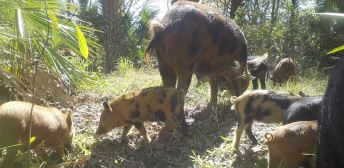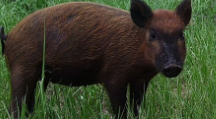
Wild pigs caught on the game camera at the Range Cattle Research and Education Center, Ona, FL. Photo Credit: Hance Ellington, UF/IFAS Extension
If you’ve noticed a group of wild pigs tearing up your fields, you’re not alone. Wild pigs are one of the most destructive invasive species in Florida, and their numbers keep growing in the Panhandle. These animals cause millions of dollars in damage every year. Additionally, they negatively impact water quality and spread diseases. For farmers and landowners, managing wild pigs is essential to protect property and keep farms productive.
You might think a sounder, a group of pigs, just appeared overnight, but they’ve likely been nearby for months. Cooler weather and changing food sources make them easier to spot in fall and winter. In the fall, pigs feed heavily on acorns, pecans, and other natural foods to build fat for winter. When these foods run out, they roam farther to find roots, plants, and insects. Less foliage and more movement across the landscape make them more visible during the cooler months. Signs of wild pig activity include rooted-up soil, muddy wallows near water, and damaged crops like corn, peanuts, and cotton. Pig pressure on crops often spikes during planting and harvest seasons. Rooting doesn’t just ruin fields, it breaks down soil structure, causes erosion, and pollutes streams with sediment and pathogens.
Wild pigs breed year-round; a single sow can have two litters a year, each with several piglets. Their high reproductive rate makes population control very difficult. Managing wild pigs takes an integrated approach. No single method will control populations indefinitely.
–
Trapping
Trapping is the most effective way to remove large numbers. Corral traps are best for catching entire sounders. There are two main types of corral traps: active and passive. Active traps use a door that drops when triggered by a root stick or remote control. These traps need regular inspection and careful setup to avoid missing pigs. Passive traps, often net style, let pigs root under to enter but prevent escape. They work around the clock but require more time and attention. Both types need pre-baiting for days or weeks, so pigs become accustomed to the trap. If bears are in the area, pigs may avoid traps, so multiple trap sites can help.
Florida law requires traps to be checked daily to prevent suffering. The best time to check is early morning. If you don’t have cameras, check again in the evening. Release non-target animals immediately. Pigs can overheat quickly because they can’t sweat, so leaving them in traps during the day can kill them. Always dispatch of pigs humanely.
–
Other Control Options
Night hunting is another tool. It’s legal on private land with permission and can help remove trap-smart pigs that avoid bait. Thermal optics make night hunting more effective, but it’s not a complete solution. Hunting works best as part of a larger plan. Fencing can protect high-value crops. Electric fencing or hog panels can keep pigs out, but they require maintenance and can be expensive. For large farms, fencing isn’t practical, but for small plots or specialty crops, it may be worth the cost. Technology can help too. Remote cameras, drones, and GPS tracking make it easier to monitor pig activity and save time when managing traps.

Wild piglet caught on a Range Cattle Research and Education Center game camera. Photo Credit: Dr. Hance Ellington, UF/IFAS
Wild pigs also carry diseases like brucellosis and pseudorabies, which can infect livestock and even humans. Experts estimate that at least 20% of wild pigs carry these diseases. Always wear gloves and eye protection when handling pigs, disinfect tools, and cook meat thoroughly if you choose to eat it. Many agencies recommend not processing wild pigs for food at all. Keep dogs away from carcasses and seek medical care if you develop flu-like symptoms after contact.
Wild pigs are a serious challenge, but with planning and persistence, you can reduce their impact. Combine trapping, hunting, fencing, and monitoring for the best results. Work with your local extension office for advice and resources. Together, we can protect farms and natural resources from this invasive species.
–
For more information on this subject, use the following publication links:
–
UF/IFAS Feral Hogs
–
FWC Feral Hogs
- Managing Wild Hogs in theFlorida Panhandle: Strategies for Farmers and Landowners - October 24, 2025
- 2025 Small Ruminant Grazing Field Day – November 5 - October 3, 2025
- After an Eventful Winter, Inspect and Prepare Equipment for the Growing Season - April 11, 2025
